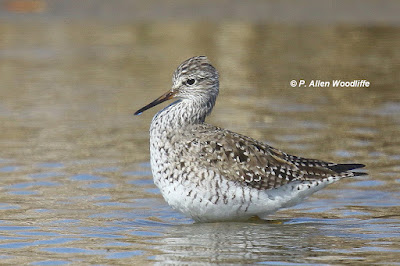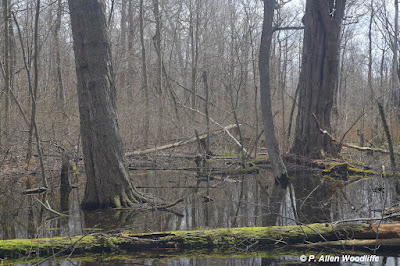The Birds of Chatham-Kent, then and now, series, will continue eventually, but right now, spring birding is heating up nicely. My previous post discussed this somewhat, based on a couple of really good days last weekend. While there hasn't been any major weather changes to bring huge numbers, that may happen over the next few days. In the meantime, there has been a very pleasing variety of birds to be found, if one is willing to cover a fair bit of habitat and area.
I have put my energy of recent days checking out places like Rondeau Provincial Park and Keith McLean Conservation Lands. It has been well worthwhile. I haven't had a 100 species day yet, but I did get an 85 species day.
Birds are scattered, with the very south end of the park being more or less the most productive, but the narrower north end of the park can be good as well. As the saying goes, birds are where you find them! It is a bonus when the photo ops occur at times, and so what follows features some of those photo ops.
There was the occasional White-throated Sparrow which over wintered, but very few. It is always a treat to see some nice fresh looking ones, and hearing them singing on occasion. It is one of the most abundant land birds in the park at the moment, with seeing several dozen quite easily as they scurry throughout the forest and edges.
Hermit Thrush is the first of the Catharus thrush species to show. It is the most common of this genus right now, but Swainson's Thrush, which follows, is running a close second, and will very soon be the most common one.
Brown Thrashers are rather skulky birds. There are a few around, although undoubtedly much more common than what any daily bird checklist will show.
Closely related to the Brown Thrasher is the Northern Mockingbird. There has been one or two lurking around the maintenance area for a couple of weeks, or in the nearby picnic area. I have seen it, or another one, on several occasions, and they usually can be somewhat cooperative for the camera.
One of the real highlights for me in the last few days was to see not one, but probably two, Sedge Wrens. Another birder reported three of this species in the same area. Given that they are very furtive, scurrying around dense grass mats and shrubby areas, there could be quite a few of this elusive species. In all of my birding/photographing years, this is the first time I have been able to successfully photograph one.
Members of the Wood Warbler group are what many birders equate with highlights of spring migration. There has been a moderate influx of species diversity considering the relative early aspect of the season. At least 16 of the ~40 species on the park checklist have been reported at Rondeau as of yesterday. I've only seen about 10 species in the last week or so. However the major part of their migration has yet to come, so there is lots of time over the next few weeks to see most of them. Will there be any new species added to the checklist? Only time will tell.
Palm Warblers are one of the early species.....
Another highlight was to see a fairly cooperative male Hooded Warbler scurrying around a brush pile at the north end of the park. This species used to be quite a rarity in Ontario, but in the last couple of decades, has gradually expanded its breeding area so that while it is still uncommon, it isn't quite the rarity it used to be.
White-breasted Nuthatch is a permanent resident of the southern Ontario woodlands. Now that the breeding season is here, it is more common to hear their 'yank-yank-yank' calls along the trails.
Of course there are other things to see along the trails as well, including butterflies such as this American Lady....
...and sometimes a dead critter. This is a Short-tailed Shrew. It didn't show any overt signs of trauma, so why it died is a mystery. They are secretive creatures that spend most of their lives in the leaf litter or underground.Eastern Gray Squirrels are abundant, of course.....
...and Spicebush is dominant throughout the wetter areas of the woodlands. It is about in peak flowering right now.
At one point I spotted this Red Fox crossing over the road from the campground, and heading south into a shrubby thicket. It wasn't apparent whether it was just on the hunt, or heading to or from a den. It is one of the few times I have seen a fox in the park, and the first time I have photographed one in the park. Their numbers have dwindled due to the high numbers of Eastern Coyotes in the park, which will prey on things like fox and feral cats etc.
As mentioned, I have also been checking out the Keith McLean Conservation Lands. There is lots of shorebird habitat, as has been the case for the last few years. There have been some rather rare shorebird types over the last few days, such as American Avocet, Willet and Marbled Godwit, but none of them have stayed for long, in some cases just a few hours at most. I didn't see any of them. Much more common are shorebirds such as Dunlin.....
Lesser Yellowlegs, next, and Greater Yellowlegs, are around in small numbers.
In the cattail edges there are lots of sparrows, including an occasional American Tree Sparrow, most of which have moved farther north.
Brown-headed Cowbirds are seldom appreciated by birders, but when a good photo op shows up such as this female, I will try and make the best of it!
Cedar Waxwings have not been all that common lately, but I saw a small flock of about 8 feeding on some berries.
The nesting platform seems to be holding the interest from a pair of Osprey.
Tree Swallows are by far the most abundant swallow species right now. Hopefully they can survive any future cold spells that sometimes occur in early May!
The main highlight for me at KMCL was this Grasshopper Sparrow. It had been hanging out in the same vicinity as an even rarer Lark Sparrow. I have not caught up to the Lark Sparrow, but did manage to see the Grasshopper Sparrow on a recent visit. It was somewhat back lit, so I had to do a bit more processing than normal to get this result. It is the first time I have photographed this species, so was glad for the opportunity!
If you would like to subscribe, or unsubscribe, to Nature Nuggets, send an email to me at: prairietramper@gmail.com

































































